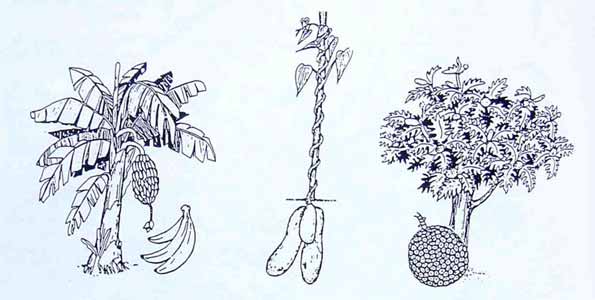|
Plants & Vegetation of the Cultivated Areas
Agroforestry (man-made forest) information
The traditional cultivation of plants has been very important to tropical Pacific Islanders for many centuries, not only for the food produced, but also for many other resources. In fact, the farming of useful plants has taken up so much of the time of so many persons in the region that a great many social relationships have affected gardening procedures, or been shaped by them. Today the people living on the outer atolls of the Marshall Islands are more strongly associated with and dependent upon the plants they cultivate than people living on the urbanized atolls of Mājro and Kuwajleen.

Illustration: Keeprañ (banana), iaam (yam), and mā (breadfruit) are three crops cultivated in the Marshall Islands. Yams are not widely cultivated. Mā is one of the most important crops on the wetter atolls.
Cultivated areas in the Marshall Islands are called jikin kallib - places reserved for planting. For many hundreds of years, the cultivation of useful herbs, shrubs, and trees has had a significant impact on the natural broadleaf forests in many areas of the Marshall Islands. Cutting, burning, planting, harvesting, and other activities have changed the natural ecosystems. Before people arrived in the Marshall Islands, dense forests of native plants probably covered much of the land area, especially in the wetter southern atolls. Most of these low island forests have been cut down. In the past, many plants and trees of the original forests were used to construct houses. And, of course, many houses - as well as other buildings, structures and roads - have displaced plant life in the Marshall Islands, especially in modern times. Areas that were once native forest are now used for growing breadfruit trees (mā) and coconuts palms (ni), as well as several other cultivated trees, taro plants (iaraj and kōtak), additional non-woody crops such as bananas (keeprañ, pinana) and papayas (keinabbu), and several ornamental flowering species.
Some islands are too small to support permanent occupation or agriculture, but members of the bwij ko (lineages) that own these lands may visit them from time to time to catch birds and to collect eggs and plant materials, including coconuts, pandanas, and breadfruit. Islands that are taboo (mo) may not be visited without the permission of the chief (irooj). These islands will also be untended and overgrown with native vegetation, but they will have food and other plants that may be gathered for the irooj. Some weedy species are also commonly found in cultivated areas.
Vegetation Zones

Individual Plants
|

